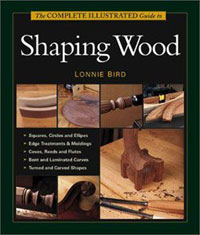
BOOK REVIEW:
Taunton's Complete Illustrated Guide to Shaping Wood, by Lonnie Bird
by J. Norman Reid
Delaplane, VA
Lonnie Bird's excellent book is exactly what its title claims—an illustrated and encyclopedic guide to the many ways wood can be brought to the shape you need for your project. Thorough and comprehensive, Bird's treatment stands out for its clarity and the step by step photos that demonstrate each technique. Each shaping method is described in sufficient detail that it can be readily employed by the woodworker.
Wood shaping can be accomplished, of course, in various ways and Bird describes several methods—using a shaper, router or hand tools—for accomplishing each task, so your approaches needn't be limited by the tools you have at hand. Accompanying most descriptions are tips for working safely and for getting the best results.
Bird first discusses the tools that can be used for shaping—layout tools, power machinery, carving and turning tools and tools for bending wood. This is followed by a brief discussion of wood stock for sawn curves, bent curves and panels.
The second part of the book is devoted to shaping by cutting. Bird's discussion of straight-edged shapes includes milling stock and cutting tapers, octagons and chamfers. He then describes making curved shapes—arcs, circles and ellipses, exterior curves and interior curves. This is followed by more complex shapes—raised panels, door frames, coopered panels and compound curves. Part Two concludes with helpful sections on cutting with templates, flush trimming, cutting profile trim and shaping inside curves.
Part Three addresses edge treatments and moldings. Included are straight edges and complex curved edges, lipped door edges, shaping a board's face, cutting a dished tabletop and beading, including cock beads. Moldings are a major focus of Part Three—simple machine-cut moldings, hand cut moldings, complex and built-up moldings and dentil moldings.
Part Four demonstrates some other decorative shapes. These include coves, cut both by machine and by hand, reeds and flutes.
Part Five deals with special techniques. First is turning basic shapes such as beads and coves on a spindle to be used for table legs. Turning furniture legs and feet, including pad feet, offset legs and pedestals, are illustrated. The section is completed with a discussion of turning decorative details such as rosettes and complex turnings, the example shown being a flame finial. A section on carving demonstrates making a lamb's tongue, shell, volute, carved rosette, carved flame finial, and trifid and ball and claw feet. The final section describes steam bending, bent laminations and kerf bending.
A brief appendix addresses shaping small parts safely.
Overall, I found this to be an outstanding guide to shaping wood and one that will occupy a central place in my woodworking library. While other, more detailed treatments of many of the techniques Bird describes can be found on YouTube or elsewhere, this guide stands out for its clarity and comprehensiveness and is an excellent place from which to begin exploring new techniques. It will be especially useful—essential even—for beginners and intermediate woodworkers and a helpful resource for advanced woodworkers. I give it a strong recommendation as a tool that belongs in every woodworker's library.
CLICK HERE to purchase your own copy of
Taunton's Complete Illustrated Guide to Shaping Wood
The author is a woodworker, writer, and woodworking instructor living with his wife in the foothills of the Blue Ridge Mountains with a woodshop full of power and hand tools and four cats who believe they are cabinetmaker's assistants.
He can be reached by email at
nreid@fcc.net
.
Return to
Wood News
front page


